SUMMARY
This is AI generated summarization, which may have errors. For context, always refer to the full article.

HONG KONG – The easiest way to describe the atmosphere in Hong Kong during the festive Chinese New Year period (or CNY, as it is popularly referred to) is to relate it to what we experience in the Philippines.
Put simply, it definitely still feels like Christmas here.
At the end of the Yuletide season and “western” New Year, the global Chinese population begins the biggest annual celebration of their own heritage – and what a truly joyous celebration it is. What it lacks in length (compared to the Philippines’ “longest Christmas season in the world”) is more than compensated for with the way the Chinese welcome the beginning of the lunar cycle established 4,710 moon years ago.
CNY is so important that it’s a 3-day holiday in Hong Kong. Schools and offices are closed, most shops and restaurants shut down (some even for as long as two weeks) and the ones that do open start operations in the mid-afternoon. I guess you can pretty much compare it to Holy Week in the Philippines (without the bloodstained self-flagellation and crucifixions).
The decor

The figure of speech “paint the town red” has its roots in relatively recent American culture. But, who knows, the phrase’s roots may find their way to China where the use of the color red during CNY dates back centuries.
I’ve heard stories about why this particular color is used, and as is often the case, one story revolves around people and monsters (I’m talking about mythical ones, and not the in-law variety; by the way, a special shout out and happy CNY to my biyenan…I love you!).
Bright red ornaments coupled with noisy firecrackers are supposed to drive monsters and evil spirits away. That is why apartment doors are decked with red signs on which are written various positive Chinese characters. While strolling through a traditional, old town market (ironically located in a place called New Territories), I saw signs of red, black, and gold that promised good fortune, health, and wisdom.

I was personally surprised at the quick turnaround of decors at the malls. One day, the Christmas trees and snowmen were still on display. But the very next morning, red, pink, and other bright colored dioramas were in their place and traditional Chinese New Year music was blaring from the sound systems.
Funnily though, one store my wife and I visited in early February forgot to replace their Christmas CD so Mariah Carey was still belting out “All I Want for Christmas is You.”
Another ubiquitous CNY decoration is the potted orange tree. The Cantonese name for these small fruits is gat tsai, whose first character phonetically sounds like “positive luck” from a traditional Cantonese phrase (daai gat daai lei).

My wife was so enamored with these trees that she half-jokingly wanted one in our living room so she could pick oranges to eat while watching TV. But then, she was told that these oranges may be poisonous so if she had eaten them, that would have been really bad gat.
What to do
With the city virtually shut down, there aren’t many things to do during the long holiday. Therefore, locals usually flock to two popular destinations.

Families and friends enjoy going to “flower markets.” Certain parks and streets are turned into makeshift night markets where you can buy flowers, decor, and cheap, flimsy trinkets that kids can enjoy for a couple of days before being thrown out.
These markets get extremely packed and you have no choice but to be dragged along to wherever the crowd decides to take you. In other words, the city puts up temporary Divisorias all around town.
The numerous temples in the city are also filled with people who wish to give thanks for what transpired over the past year. It is here that you will find lion dances, incense sticks standing tall in urns of gray ash, symbolic paper money being tossed into fires, and fortunes being told by geomancers and monks to those who wish to find out what prospects await them in the new year.
Family time

This may sound unusual to many of us, but for a few Hong Kong folks I’ve spoken to, Christmas and New Year are holidays typically spent with friends while Chinese New Year is really the special time when families come together to enjoy each other’s company.
Some families eat out in the evening so restaurants – particularly Chinese restaurants – are always busy. But others prefer to stay home and partake of traditional holiday delicacies. Just as noche buena isn’t complete without hamon and queso de bola, families here cannot have lunar new year dinners without tikoy (lin go) and radish cake (loh bak go).
The Chinese character go sounds like the word “tall” in Cantonese. For kids, eating these cakes symbolizes their continued physical growth in the new year. For adults, it symbolizes that they will continue to climb up career ladders. (And for me, it means that my cholesterol levels will shoot off the charts again from all the oil and eggs that go into pan frying these babies.)
Finally, there is also the concept of lai see, which is the traditional red envelope filled with money, something that kids of all ages here look forward to. And here I thought that the phenomenon of the disappearing ninong was exclusive to the Philippines, but they exist here, too. Finally, a touch of the familiar!
Celebration for everyone

Being of Chinese descent, our family has been celebrating CNY in the Philippines ever since I can remember. But I never found it as festive as Christmas, probably because it was never a recognized national holiday. All we ever did was share a good family dinner on Chinese New Year’s eve, and then be off to school or work the next day. It truly felt like a half-baked, pseudo-holiday.
Being in Hong Kong has put me more in touch with just how important CNY is to those of Chinese heritage and it is fortunate that my family is given the opportunity to experience it as such. It may take time for us to build as strong an emotional bond with CNY as Hong Kong locals, but this year is a start.
And as I think about it more, just like Christmas and New Year back home, CNY is really a time to pause from everyday stress, count blessings and spend time with loved ones – all very good reasons to celebrate, whatever time of the year it is. – Rappler.com

Add a comment
How does this make you feel?
There are no comments yet. Add your comment to start the conversation.